Contents
The Californian rabbit belongs to the breeds of the meat direction. The breed was bred in the US state of California. Three breeds of rabbits took part in the creation of the Californian breed: chinchilla, ermine and New Zealand white. The purpose of breeding the Californian breed was to obtain a broiler breed of rabbits, quickly gaining weight and adapted to industrial cultivation on mesh floors of cages on industrial rabbit farms.
The subtlety here is that rabbits living on the net often injure their feet on the wires, getting the so-called “corns” or pododermatitis. Protection against pododermatitis can be thick hair on the feet of rabbit paws.
The Californian rabbit has a minus, apparently common, in general, for all breeds that are called broilers: the Californian breed is demanding on temperature conditions and is not suitable for keeping outdoors, which is often practiced in Our Country.
California breed standard
Like all broiler breeds, California rabbits should produce maximum meat yield and minimum bone count. Therefore, with a general strong constitution, representatives of the Californian breed have a light, thin skeleton.
The maximum amount of meat in rabbits is on the hind legs, respectively, the Californian has an extended sacro-lumbar region and well-muscled hind legs. And the body, on which there is little meat, is compact.
Broiler breeds do not need long legs, and they are also short in California rabbits.
The head is small and light. The length of the ears does not exceed 10,5 cm.
The weight of an adult animal of the Californian breed is 4-5 kg.
Features of the color and quality of the skin of the Californian breed
Since the Californian rabbit was bred with the participation of three breeds, he took the best from them: delicious meat from the chinchilla; from the New Zealand white the ability to grow rapidly; from the ermine color and skin quality.
The color of the rabbit of the Californian breed is similar to the color of the ermine so much that it is easy to confuse them. Although there are differences, of course. Pictured below is a Californian breed.
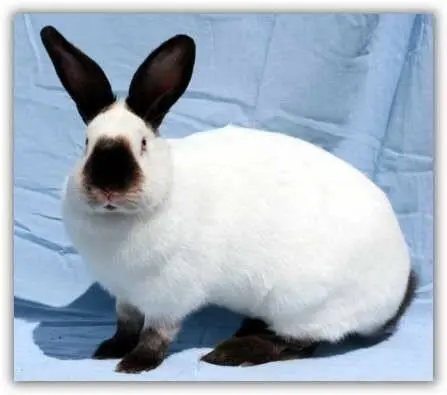
And in this photo, a ermine rabbit.
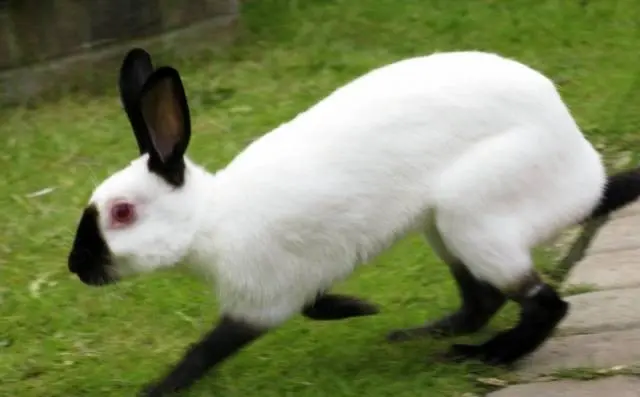
Ermine markings are larger and darker. Although in reality it will be very difficult to distinguish between these two breeds of rabbits, since the size and saturation of the marks depends on the air temperature.
Rabbits of these breeds are born white, markings appear later. Moreover, the lower the air temperature at the time when the marks appear, the more saturated and larger these dark areas are.
Photo of another breed of rabbits, similar in color to the Californian.

This is a butterfly rabbit. It is really possible to confuse this breed with the Californian only out of inexperience. The butterfly breed is distinguished by the presence of black spots on the body and the absence of dark marks on the paws. But at a young age, rabbits can be similar. To accurately determine the breed, it is enough to look into the eyes of the rabbits. Californian rabbits have red eyes, while those of the “butterfly” are dark.

Features of the Californian breed
Although the Californian is an industrial breed, keeping Californian rabbits by private owners is also not difficult. Perhaps the animals will grow a little slower, but this is usually not important for private traders, since private traders do not have the number of rabbits to incur serious losses, but there is usually not enough time to slaughter.
The Californian breed has a calm disposition, which is why rabbits of this breed are increasingly kept as pets. And here the next details of rabbit organisms are revealed: although the Californian is advertised as a breed that can live on mesh floors, in fact, such floors are harmful to any breed of rabbits. If possible, the animals should be provided with a smooth floor to avoid pododermatitis.
On a rabbit farm, this is not possible, because there productivity comes first. In the apartment, the rabbit can be equipped with a comfortable cage. It is not difficult to clean up after one animal.
Private owners who keep several rabbits, depending on their ingenuity, find a variety of options: from a galvanized sheet of iron with holes punched in it for urine drainage to keeping animals in pits.
Differences between ways of keeping rabbits
There are three methods of keeping rabbits: in a cage, in an aviary and in a pit.
Voliary
Experienced rabbit breeders have long abandoned aviaries, since the aviary is a piece of land fenced with a net, open from the sky. The aviary net is usually deepened half a meter into the ground so that the rabbits cannot dig a passage under it to freedom. Boxes are placed in the aviary as a shelter for animals. But the economic losses of rabbit breeders with this method of keeping are very high.
Firstly, the rabbits fight among themselves, and it is impossible to get a high-quality skin with such a content. Secondly, the rabbits do not know that they cannot undermine the net, so they periodically undermine and run away. Thirdly, predators, feathered and four-legged, are unfamiliar with the concept of “alien property” and are happy to catch defenseless animals.
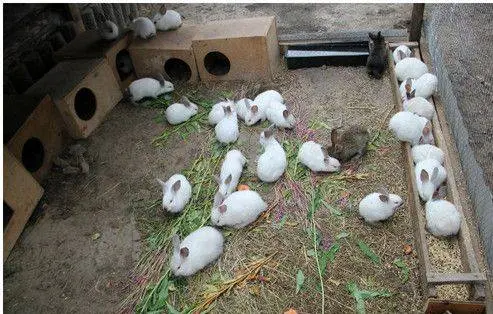
Pit
Someone believes that this method is most consistent with the natural lifestyle of rabbits. They suggest making a hole 1 m deep, cementing the bottom to prevent feces from getting into the ground and “leaving rabbits to their fate.” According to the idea, in the side walls of the pit, the rabbits themselves will dig holes, which will then need to be equipped with dampers. You can start digging holes yourself. The rabbits will continue.

In theory, it is believed that animals will not get out of the pit, as they dig passages either horizontally or with a downward slope. At the same time, for some reason, no one thinks about where, in this case, in nature, rabbits take the second and third exits from the hole. And since the rabbits themselves are well aware that they also dig passages with a rise to the surface, periodically rabbit breeders who breed animals in a pit are forced to fill such passages with concrete to freedom and artificially dig the right hole for rabbits nearby.
Also, the minuses of the pit include:
- the difficulty of catching extra individuals;
- spoiled skins;
- possible compacted rounds of rabbits due to the free access of rabbits to females;
- the inability to provide rabbits with an individual diet.
It would be a plus that, according to the statements, the rabbits in the pit are no longer afraid of rats. But the rats themselves may not know what they write about them on the Internet, but be well aware of how to dig holes in the ground. And leftover food will surely attract rats.
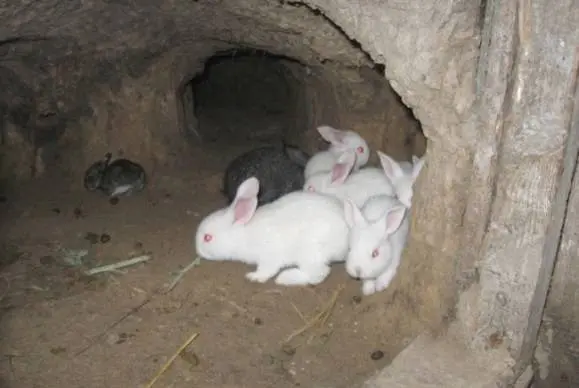
This is to the question of whether there are rats in the pits. Only rats and rabbits can answer it accurately.
Given that Californians are a heat-loving breed, living in a pit may not suit them.
Cell
A well-made cage is guaranteed to protect rabbits and their cubs from rats, and the residence of each animal in a separate cage will save the skin and allow the animals to be given individual diets.
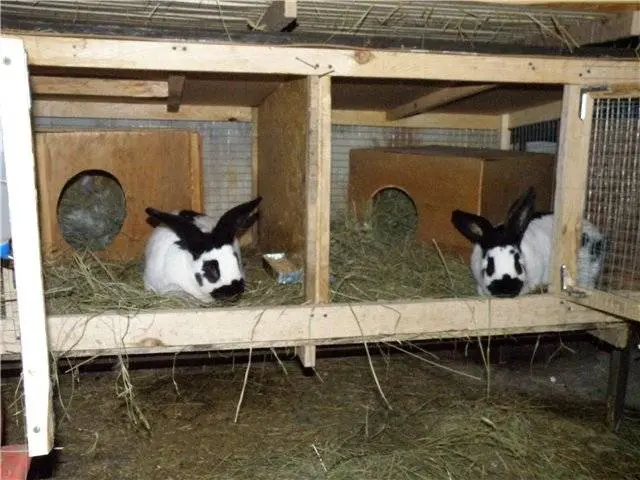
The insulated cage allows you to keep rabbits outside even in winter. If the cage is additionally equipped with a heated mother liquor and a heated drinker, then up to -10 degrees the rabbit has nothing more to wish for. In more severe frosts, it is better to bring cages with animals into the room.
Feeding
Regarding the rabbit diet, there are two points of view.
The first originates from the moment of domestication of rabbits. It is believed that the animals need carrots, grass, cabbage, silage and other succulent feed in addition to hay and grain mixtures.
The second appeared with the development of industrial rabbit breeding and the advent of complete granules, designed specifically for the fastest possible rearing of rabbits in industrial conditions.
Considering that California rabbits were bred for industrial farms, the second food option is more suitable for them. It is also less labor intensive for owners. In addition, succulent foods often cause bloating in rabbits.
Rabbit diseases
There are no specific diseases inherent only to this breed in the Californian breed. California rabbits suffer from all the same diseases as other rabbits.
Two of them are especially dangerous and are capable of destroying the entire livestock of animals on the farm. This is a viral hemorrhagic disease of rabbits and myxomatosis.
VGBK
The virus is transmitted through the feces of recovered animals, through the contact of a healthy rabbit with a sick one, through equipment and clothing of staff. Even in skins taken from sick animals, the virus persists for up to 3 months.
The incubation period of the disease lasts from 2 to 5 days. In the case of a fulminant form of the disease in the morning, outwardly healthy rabbits are already dead by the evening.
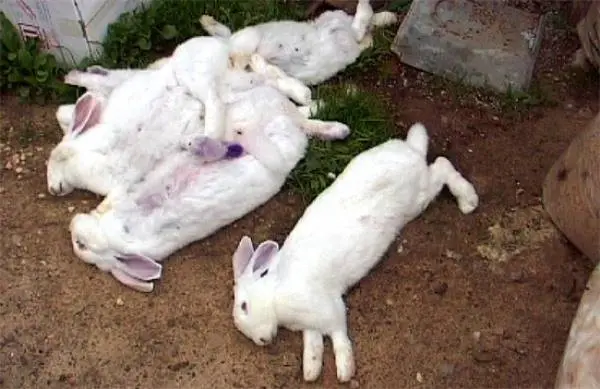
The disease does not last longer than 4 days, and mortality reaches 100%.
For the prevention of HBV disease, animals are vaccinated every six months, starting with the third vaccination. The first and second are done at 45 and 105 days.
Myxomatosis
The disease is transmitted by blood-sucking insects and by direct contact with a sick animal. Moreover, the virus in the bloodsucker can remain active for six months.
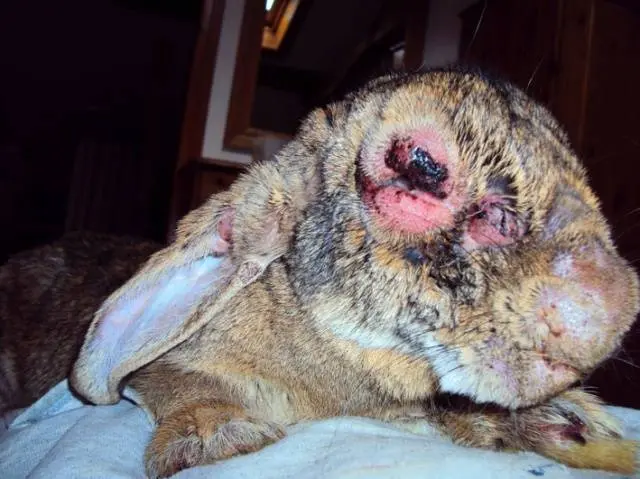
Mortality, depending on the form of the disease with myxomatosis, ranges from 30 to 70%.
For a long time, a rabbit that has been ill remains a carrier of the myxomatosis virus.
With an outbreak of myxomatosis on a farm, the entire population of rabbits is slaughtered, since even “recovered” animals will serve as a source of infection for newly purchased rabbits, and the disease will flare up again.
Rabbits are vaccinated against myxomatosis at different times, which depend on the type of vaccine.
Since once ill rabbits no longer get sick with this disease, it is possible to vaccinate a rabbit at the age of 30 days with a single monovalent vaccine. Twice the vaccine against myxomatosis is injected only in regions that are unfavorable for the disease.
Other rabbit diseases
Pasteriosis and coccidiosis (eimeriosis) are also quite dangerous and contagious diseases. Pasteriosis can be vaccinated against. There is no vaccine for coccidiosis, as it is an invasive disease. But in this case, you can carry out prevention.
Of the non-contagious, but very dangerous diseases for a particular animal, one can single out the so-called bloating, which is actually not a disease, but only a symptom of the disease. The only case when the swollen belly of the animal indicates an infection is with coccidiosis. In all other cases, bloating is usually caused by fermentation in the intestines and the formation of intestinal gases after eating wet grass, fresh cabbage, sour silage and other foods with a tendency to ferment.
Often, with bloating, the animal dies within a few hours, either from suffocation when the lungs are squeezed by the stomach, or when the intestinal walls rupture and the further development of peritonitis.
To avoid problems with bloated bellies, it is recommended that rabbits be fed only hay and complete pellets.
Reviews and videos about rabbits of the Californian breed
On the Internet you can find quite a lot of reviews and videos about the Californian breed.
A kind of promotional video about a Californian from the owners of the Moryak private household farm, which breeds European rabbits:
Expert evaluation of the Californian breed:
Feedback from owners of California rabbits
Conclusion
The Californian breed may not be very suitable for beginners, but if a rabbit breeder is already experienced with rabbits and wants to try moving into raising meat rabbits for sale, then the Californian breed is one of the best choices.









